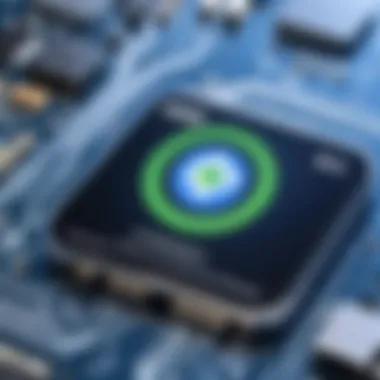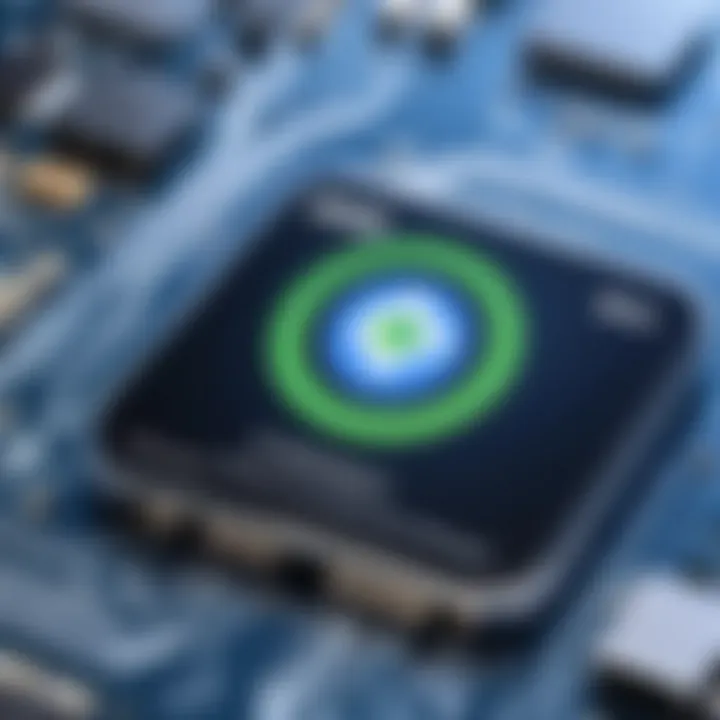Understanding ADB and Fastboot: Essential Tools for Android


Intro
In the landscape of Android development, ADB and Fastboot stand out as two pivotal tools. They provide developers and enthusiasts with an interface to communicate with Android devices. Understanding these tools can significantly enhance your ability to manage and troubleshoot Android devices.
ADB, or Android Debug Bridge, is crucial for various operations during development. It enables a command-line interface that allows for the execution of commands directly on an Android device connected via USB. Fastboot complements ADB by offering a method to interact with the bootloader of Android devices, making it essential for tasks such as unlocking bootloaders and flashing custom recoveries.
Both tools can help streamline the development process and are integral for anyone looking to modify or troubleshoot their Android devices.
Overview of the Technology
Key Specifications
ADB functions primarily as a client-server model, where the client communicates with the server through a USB or wireless connection. It runs on three main components:
- Client: Initiates commands from a development environment.
- Daemon: Runs on the Android device, listening for commands from the client.
- Server: Manages communication between the client and the daemon.
Fastboot operates by providing access to the bootloader, allowing users to perform various operations like flashing files and unlocking devices. Its architecture also revolves around a client-server model, enabling seamless communication.
Unique Selling Points
- Versatility: ADB and Fastboot can facilitate actions ranging from data transfer to system recovery.
- Accessibility: These tools are readily available and can be installed on various operating systems.
- Powerful Functions: Advanced users can utilize these tools for tasks like rooting and installing custom ROMs, enhancing device utility.
"The combination of ADB and Fastboot represents a powerful toolkit available for Android users, helping to streamline operations that would otherwise require sophisticated technical knowledge."
Design and Build Quality
Material Used
In terms of software architecture, ADB and Fastboot rely on robust frameworks written primarily in C/C++. These platforms are designed for efficient performance and stability when working with Android devices.
Ergonomics and Usability
Usability is a hallmark of ADB and Fastboot. Their command-line interfaces may seem intimidating to beginners but offer powerful capabilities. Documentation for both tools is widely available, enabling users to easily learn commands and operations. The learning curve, while present, rewards users with extensive control over device management and modification.
Intro to ADB and Fastboot
In the realm of Android development, ADB (Android Debug Bridge) and Fastboot stand as two pillars. Understanding these tools can significantly enhance how developers and enthusiasts manage Android devices. Knowing what ADB and Fastboot are and their specific applications is crucial for anyone delving into Android customization or troubleshooting.
Definition of ADB
ADB is a versatile command-line tool that allows communication between a computer and an Android device. It enables developers to perform a variety of operations directly from the command line. This includes installing and uninstaling apps, accessing the device's shell, and managing files on the device. ADB acts as a bridge for sending and receiving commands and data, making it a fundamental resource for developers looking to debug their applications and interact with their devices effectively.
Definition of Fastboot
Fastboot is a protocol that enables communication with your Android device when it is in bootloader mode. Unlike ADB, which operates when the operating system is running, Fastboot provides access to the bootloader environment of the device. This allows users to flash custom recovery images or alter the system partitions. Fastboot is essential for those who wish to modify their devices at a deeper level, such as rooting or installing alternative firmware. Using Fastboot, commands can be executed to unlock the bootloader, flashing images, or even rebooting into recovery mode.
Importance of ADB and Fastboot in Android
The significance of ADB (Android Debug Bridge) and Fastboot in Android development cannot be overstated. These tools form the backbone of Android device management, offering a wide array of functionalities that enhance user experience and developer efficiency. Their capabilities range from simple troubleshooting to complex application deployment, making them essential for both novice and experienced users.
Role of ADB
Device Management
Device management is one of the primary functions of ADB. It allows users to interact with their devices from a computer, enabling actions like file transfers, app installations, and even running commands straight from the terminal. This capability improves the way developers manage their application environment. One key characteristic of device management through ADB is its ability to provide a bridge between the computer and Android device, offering a wide range of options without the need to directly manipulate the device screen.
Benefits of using ADB for Device Management:
- Simplicity: ADB commands allow quick and efficient management of apps and files.
- Control: Users can perform intricate tasks that would be difficult through the usual device interface.
- Automation: Repetitive tasks can be scripted to save time.
However, one disadvantage is that users must have a basic understanding of command-line interfaces to utilize ADB effectively. This requirement can deter some less tech-savvy users, limiting the accessibility of these powerful tools.
Application Installation and Debugging
Application installation and debugging through ADB streamline the development process. Developers can install apps directly onto their devices without navigating through Google Play Store, which can be particularly useful for testing purposes. Furthermore, ADB provides logcat, a tool that assists in debugging various issues that may arise in applications.
Key characteristics of this function include:
- Efficiency: Instead of installation via the UI, ADB allows for faster and more controlled deployment.
- Immediate Feedback: Developers can see real-time feedback from devices without switching between different windows.
Yet, this feature may have a downside. If not handled properly, using ADB for application installation and debugging can lead to instability in the application environment. Careful management is required to avoid potential conflicts with pre-installed apps or system settings.
Role of Fastboot
Bootloader Access
Fastboot facilitates bootloader access, which is crucial for low-level device management. Accessing the bootloader allows users to perform operations like unlocking the bootloader, which in turn enables custom firmware installations and performance enhancements. This role is beneficial for advanced users seeking to modify the functionality of their devices.
Notable characteristics include:
- Direct Control: It provides direct access to device partitioning and flashing.
- Flexibility: Users can easily switch between different Android versions.
However, unlocking the bootloader may void warranty or lead to device malfunctions if not handled carefully. This risk must be considered when performing operations via Fastboot.
Device Flashing
Device flashing is another critical aspect provided by Fastboot. It allows users to install a new operating system or recoveries when facing software issues. This ability is advantageous for those experiencing serious operational problems or who wish to customize their user experience.
Key characteristics include:
- Customizability: Users can tailor their devices to their liking by flashing custom ROMs.
- Recovery: Flashing can restore malfunctioning devices to a usable state.
Despite its benefits, flashing can lead to issues such as bricking a device if the process is not done correctly. Therefore, it is essential to follow detailed instructions and understand the risks involved.
In summary, ADB and Fastboot are foundational tools in Android development. Their advantages in device management and application handling significantly enhance the overall Android user experience. However, users must proceed with caution, as improper usage can lead to complications or device issues.
The advantages brought by ADB and Fastboot undeniably encourage their use among developers and tech enthusiasts, who appreciate control over their devices and applications.
Prerequisites for Using ADB and Fastboot


To effectively utilize ADB and Fastboot, understanding the foundational requirements is essential. Without these prerequisites, users could face obstacles that hinder their ability to perform tasks efficiently. This section explains the significant aspects regarding compatible operating systems and the minimum system requirements that provide a solid foundation for using these tools.
Compatible Operating Systems
Windows
Windows is one of the most popular operating systems globally, and it plays a critical role in Android development through ADB and Fastboot. Its broad user base makes it a favored choice due to familiarity and compatibility with many software tools. A notable aspect of Windows is its user-friendly interface, which allows even less technically inclined users to access the command line interface needed to interact with ADB and Fastboot.
However, Windows does have specific requirements. One unique feature is the need for drivers to facilitate communication between the computer and Android devices. This necessity adds complexity but also gives users an opportunity to learn about device management. Users must also ensure they often update their system to avoid compatibility issues.
macOS
macOS is esteemed by many developers for its robustness and reliability. This operating system contributes significantly to the ADB and Fastboot experience. The core characteristic of macOS is its seamless integration with Unix-based systems, which makes it easier to execute commands in the Terminal. This compatibility is a major benefit for developers and tech enthusiasts.
A distinct aspect of macOS is that it usually comes pre-installed with the necessary command line tools, reducing the setup time considerably. Nevertheless, users should be careful about permissions that can sometimes restrict device access, depending on their system settings.
Linux
Linux appeals to a niche group of tech enthusiasts and developers. It is known for its flexibility and open-source nature, which enhances the capabilities of ADB and Fastboot. A key characteristic of Linux is its robust command line interface, inherently suited for power users who prefer scripting and customizations. This attribute can help streamline development workflows.
The unique feature of Linux is its active community support, where users can easily find solutions to common problems or share scripts for ADB and Fastboot tasks. However, users should note that drivers may not always be straightforward to install, and an understanding of the terminal commands is often mandatory for effective utilization.
Minimum System Requirements
To ensure smooth functioning of ADB and Fastboot, it is vital to meet the minimum system requirements. These include:
- Operating System: Windows 7 or later, macOS 10.12 or later, or compatible Linux distribution.
- Processor: A dual-core processor or better is recommended to handle multiple operations concurrently.
- RAM: A minimum of 4GB of RAM is suggested for optimal performance, allowing for smoother multitasking.
- Storage: At least 500MB of free space on your system is advisable to install ADB and Fastboot along with any additional necessary tools.
Failures to meet these requirements could not only limit the functionality of ADB and Fastboot but could also lead to frustrating experiences during device management and troubleshooting.
Downloading ADB and Fastboot
Downloding ADB and Fastboot is crucial for anyone serious about Android development or troubleshooting. These tools facilitate communication between an Android device and a computer, making it easier to perform important tasks like debugging and installing applications. Therefore, understanding how to acquire these tools from reliable sources is essential for their effectiveness and security.
When downloading ADB and Fastboot, ensuring you use trustworthy sources is critical. This guarantees that the versions you obtain are safe and free from malware. Familiarity with the different ways to download these tools can enhance your experience and provide better integration within your development environment.
Official Sources
The best way to download ADB and Fastboot is through official sources. Google provides the Android SDK Platform Tools, which include these utilities as part of the Android development kit. Using the official version ensures you have the latest updates and security patches. You can obtain the tools directly from the official Android developer website. Here’s a simple process to follow:
- Navigate to the Android Developer's website.
- Choose the right version for your operating system (Windows, macOS, Linux).
- Download the package and follow the installation instructions included in the documentation.
By using official sources, users can also access helpful documentation and support that further enrich their understanding of ADB and Fastboot functionalities.
Alternative Sources
While official sources are the most secure option, sometimes users might explore alternative repositories. Websites like GitHub might host community forks or additional packages, but caution is advised. Using non-official sources could introduce risks such as outdated tools or potential malware. It’s crucial to ensure that you verify the legitimacy of these repositories before downloading:
- Check community reviews: Look for user experiences and feedback on platforms such as Reddit.
- Inspect the repository: Ensure that the GitHub maintainer has a good reputation and that the code appears well-maintained.
Downloading ADB and Fastboot from alternative sources can be viable but should be done with care to avoid compromising your system's security.
Installation Process for ADB and Fastboot
The installation process for ADB and Fastboot is a critical component of utilizing these tools effectively. Understanding how to set up ADB and Fastboot on your particular operating system lays the foundation for efficient command execution and device management. Each operating system has unique steps that need to be followed precisely. This section will delve into the specific installation steps for Windows, macOS, and Linux. Readers will gain insights into what to expect during the installation and considerations that may arise.
Windows Installation Steps
Installing ADB and Fastboot on Windows requires a few steps. The following is a straightforward process:
- Download the SDK Platform Tools: Visit the Android Developer website to download the SDK Platform tools. Ensure you select the correct version for Windows.
- Extract the ZIP file: Once downloaded, locate the ZIP file in your Downloads folder. Right-click and select "Extract All.” Choose your destination folder, preferably one that is easily accessible, like "C:\adb".
- Open Command Prompt: Press , type , and hit Enter. This opens the Command Prompt.
- Navigate to the folder: Use the command to navigate to the folder where you extracted the files. For example:
- Test ADB: Connect your Android device to the computer via USB. Type in the Command Prompt and press Enter. This should list your device, indicating ADB is installed correctly.
Make sure you have enabled USB debugging on your Android device for connection.
macOS Installation Steps
For macOS users, installation involves slightly different steps but remains straightforward:
- Download the SDK Platform Tools: As with Windows, head over to the Android Developer website and download the macOS version of the SDK Platform Tools.
- Extract the ZIP file: After downloading, locate the ZIP file in your Downloads folder. Double-click on the file to extract it in the same location.
- Open Terminal: You can find Terminal by searching for it in Spotlight or by navigating to Applications -> Utilities.
- Navigate to the folder: Use the command to reach the directory where you unpacked the tools. It would look something like:
- Test ADB: Connect your Android device and run the command in the Terminal. Your device should appear in the list, confirming a successful installation.
Linux Installation Steps
Linux users can follow these steps for installation, which is neither too complicated nor too easy:
- Download the SDK Platform Tools: Access the Android Developer website and download the Linux version of the SDK Platform Tools.
- Extract the TAR file: Open a terminal and use the command to extract the downloaded file. For example:
- Navigate to the folder: After extraction, enter the directory:
- Test ADB: Connect your Android device. To test the installation, execute in the terminal. Your device should show up, signaling a correct setup.
The End
In summary, the installation process for ADB and Fastboot on Windows, macOS, and Linux requires careful attention to detail. Each platform has a unique set of steps, but the overall process aims to prepare your environment for using ADB and Fastboot efficiently. After proper installation, users will be positioned to leverage the capabilities of these powerful tools in Android development and management.
Setting Up ADB and Fastboot
In the realm of Android development, setting up ADB and Fastboot is more than just a prerequisite; it serves as the backbone for a comprehensive device management experience. These tools empower developers and tech enthusiasts alike to interact with Android devices on a sophisticated level, beyond the limitations of standard user interfaces. Proper setup ensures that commands can be executed smoothly, enabling efficient debugging, device flashing, and configuration.
Understanding how to configure these tools and verify their installation is crucial, especially in a landscape where updates are frequent and device compatibility varies. In this section, we will explore how to configure environment variables and verify the installation of ADB and Fastboot to harness their full potential.
Configuring Environment Variables
Configuring environment variables correctly can simplify the use of ADB and Fastboot commands across your operating system. This process ensures that you can invoke these tools from any command-line interface without specifying their entire installation path. Here’s how to do it for various operating systems:
- Windows:
- macOS:
- Linux:
- Right-click on "This PC" or "Computer" and select "Properties".
- Click on "Advanced system settings".
- In the System Properties window, click on "Environment Variables".
- In the System Variables section, locate the variable named and click on "Edit".
- Add the path to your ADB and Fastboot directory, usually something like .


- Open a Terminal window.
- Type or (depending on your shell).
- Add the line .
- Save the changes and exit.
- To apply changes, type or in Terminal.
- Use a Terminal window.
- Open your or file using a text editor like or .
- Add .
- Save the file and close the editor.
- Type or to update the changes in the current session.
Configuring these variables allows for a more streamlined workflow, making it quicker to execute ADB and Fastboot commands without navigating through complex directory structures.
Verifying Installation
After setting up ADB and Fastboot, verifying the installation is essential to ensure everything works correctly. This step helps identify any potential issues early on. To verify the installation:
- For ADB:
- For Fastboot:
- Open a command prompt or terminal window.
- Type the command . This will display the version of ADB installed on your system.
- In the same command prompt or terminal, type . This ensures that Fastboot is correctly installed and ready for use.
If either command returns an error or does not recognize the command, revisit your installation steps and environment variable configuration. Often, minor errors in path settings can lead to significant frustration.
By following these setup and verification steps, you position yourself to maximize the capabilities of ADB and Fastboot, thus allowing for an efficient Android development process.
Using ADB: Basic Commands
Using ADB (Android Debug Bridge) is crucial for anyone engaging in Android development or troubleshooting. It provides a command-line interface that allows users to communicate with their devices effectively. Understanding basic commands is the first step towards harnessing the full potential of ADB.
The ability to connect devices and execute commands remotely can greatly enhance the efficiency of tasks like app installation, debugging, and device management. This section explores key commands, emphasizing their role and practical applications.
Connecting Devices via ADB
Connecting devices via ADB is the initial step for any interaction with the Android system. It establishes a bridge between the computer and an Android device. To connect a device, the user must enable USB Debugging in the Developer Options of the device settings. Once connected, issuing commands from the terminal allows for effective interaction with the device.
Steps to connect
- Enable USB Debugging on the Android device.
- Connect the device to the computer via USB.
- On the command line, execute the command .
This command displays the list of connected devices, confirming a successful connection.
Common ADB Commands
Common ADB commands are essential tools that extend the functionalities of Android devices. Below are three significant commands, each fulfilling specific needs in device management.
adb devices
The command plays a vital role in recognizing whether the connected device is properly identified by the ADB. Its primary function is to list all devices attached to the computer.
- Key characteristic: It provides an immediate overview of all devices linked via ADB.
- Benefits: Ensures the device is ready for further commands.
- Unique feature: It displays device identifiers, which is useful for managing multiple devices at once.
- Advantages: Quick and reliable connection confirmation.
adb install
The command is used to install applications onto an Android device from the command line. This process streamlines the installation, making it convenient for developers and testers.
- Key characteristic: Simplifies app deployment without navigating through the device’s interface.
- Benefits: Facilitates faster testing of applications.
- Unique feature: Can install APK files directly from the computer.
- Advantages: Allows uninstallation or apk updates via command line, saving time.
adb push and pull
The and commands serve as essential tools for file transfer between a computer and an Android device. These commands provide convenience in both directions, facilitating easy data exchange.
- Key characteristic: uploads files to the device, while downloads files to the computer.
- Benefits: Enables easy management of files without needing additional applications.
- Unique feature: Supports large file transfers, which is not always seamless via traditional methods.
- Advantages: Saves time and enhances efficiency in data management.
In summary, leveraging basic ADB commands empowers users to manage Android devices with precision and efficiency.
Understanding these fundamental commands sets a strong foundation for more advanced Android operations and enhances overall productivity in development and troubleshooting.
Using Fastboot: Basic Commands
Using Fastboot effectively is crucial for Android developers and enthusiasts. This section delves into the basic commands that Fastboot offers, which are essential for managing Android devices at a deeper level. Variables like device flashing and recovery access become more comprehensible with an understanding of these commands. Mastery of Fastboot commands can significantly enhance the user experience for anyone tuning their Android devices.
Accessing Fastboot Mode
To engage with Fastboot, one must first access the Fastboot mode on the Android device. Typically, this is achieved by turning off the device and then simultaneously pressing the power and volume down buttons. This combination varies slightly across different manufacturers, so checking the specific method for your device is wise. Once the device is in this mode, it allows the computer to communicate with it through Fastboot, providing a gateway to various commands.
Common Fastboot Commands
Fastboot commands are the backbone of managing Android device firmware. Knowing how to use them can assist in various tasks like unlocking bootloaders, flashing images, or rebooting devices. Here are some of the most frequently used commands:
fastboot devices
The command is pivotal in identifying connected devices. It lists all devices linked to the computer that are currently in Fastboot. This command ensures that your computer recognizes the device before you proceed with further actions. Its simplicity is beneficial; it's often the first command run after establishing a connection. One unique feature is its ability to diagnose connection issues right away, making it a reliable initial step for troubleshooting.
fastboot flash
The command is essential for flashing images onto the Android device. This command allows users to write data directly to the device's partitions, such as the recovery or boot images. The key characteristic of is its capability for custom firmware installations, which is a significant aspect for developers and custom ROM enthusiasts. However, users must be cautious, as incorrect usage can lead to device bricking.
fastboot reboot
The command is straightforward but vital. As the name suggests, it reboots the device from Fastboot mode back to the operating system. The command emphasizes ease of transition back to user space after executing other commands. This command serves as a final step after flashing or modifying the device. The unique aspect is its user-friendliness, minimizing complications after advanced operations.
Mastering Fastboot commands enhances device management capabilities. It unlocks potential for customization and troubleshooting.
Troubleshooting Common Issues
When working with ADB and Fastboot, encountering problems is not uncommon. Understanding how to effectively address these issues is crucial. Proper troubleshooting not only saves time but also enhances the overall experience when manipulating Android devices. As these tools heavily rely on connection stability and command execution accuracy, it is essential to grasp the common pitfalls and their corresponding solutions. With such knowledge, users can avoid frustration and streamline their development process.
Connection Problems
Connection issues are among the most frequent challenges users may face. When ADB or Fastboot does not acknowledge a connected device, it results in a bottleneck that can halt troubleshooting activities. Here are some common causes of connection problems:
- USB Debugging Disabled: Ensure that USB debugging is enabled on the Android device. This is a fundamental step required to establish a connection through ADB.
- Faulty Cable or Port: Sometimes, the physical connections can be the culprit. Verify that the USB cable is functional and that the port is not damaged or dirty.
- Driver Issues: On Windows, having the correct drivers installed can make or break the connection. Ensure that the necessary device drivers are up to date.
- Host Issues: Occasionally, the computer itself may have issues recognizing the device. Restarting the computer can sometimes resolve unusual behaviors with detection.
To diagnose these connection problems, use the command:


This command lists the devices connected. If your device does not appear, recheck the steps mentioned. Once you're able to establish a successful connection, you can proceed confidently with your tasks.
Command Errors
Command errors can be equally frustrating, often occurring due to syntax mistakes or improper usage of the commands in ADB or Fastboot. Recognizing and correcting these errors is necessary to proceed with the intended operations.
- Typos or Incorrect Syntax: Double-check the command syntax; even a minor typographical error can prevent the command from executing. For example, using instead of will throw an error.
- Unsupported Operations: Sometimes, users may attempt to run commands that are not supported on their particular device or version of ADB/Fastboot. Always consult the command's documentation to confirm it applies to your setup.
- Permissions Issues: Certain commands may require elevated permissions. On Unix-based systems, you might need to prefix your commands with to grant appropriate permissions.
To troubleshoot command errors, review the specific error message returned in the terminal. This can provide insight into what might be going wrong. Consider testing commands on a different device if possible, as it can help identify if the issue stems from the device itself or the command being executed.
"Effective troubleshooting requires patience and a systematic approach to identifying and eliminating potential issues."
By understanding these common challenges and effective resolutions, users can enjoy a smoother experience while utilizing ADB and Fastboot.
Advanced ADB and Fastboot Techniques
Advanced techniques related to ADB and Fastboot provide crucial capabilities for users who want to push the limits of their Android devices. Beyond the basic installation and command execution, these techniques enable customization, automation, and enhanced control over Android devices. Understanding these advanced methods is key to optimizing the use of ADB and Fastboot, allowing for effective device management and troubleshooting.
Scripting with ADB
Scripting with ADB involves creating scripts to automate common tasks that would otherwise require manual input through command-line interfaces. These scripts can execute a series of ADB commands in a specific sequence, saving time and reducing the risk of human error. Users can create shell scripts on platforms like Windows, macOS, and Linux to streamline operations such as app installations or data backups. Here are benefits of scripting with ADB:
- Efficiency: Automating repetitive tasks speeds up the workflow.
- Consistency: Scripts ensure that commands are executed in a uniform manner every time.
- Error Reduction: Minimizes the possibility of errors that can happen during manual entry.
To start scripting with ADB, you might create a simple shell script like below:
Users should ensure that they have the correct file paths and permissions set on their devices for the script to run smoothly.
Custom Recovery Using Fastboot
Fastboot’s capability to flash custom recoveries is a powerful feature for advanced users who seek more control over their devices. Custom recoveries such as TWRP (Team Win Recovery Project) allow for installing custom ROMs, backing up the Android OS, and performing advanced system repairs.
Custom recoveries enhance user experience significantly with features like:
- Backup and Restore: Custom recoveries provide a means to create complete device backups.
- Flashing Custom ROMs: Users can install different Android OS versions tailored to their needs.
- Mounting Storage: Access to device storage can facilitate easier file management.
To flash a custom recovery using Fastboot, follow these steps:
- Boot your device into Fastboot mode.
- Connect your device to the computer.
- Open a command prompt or terminal window.
- Type the command:
- Once flashing is complete, reboot the device using the command:
By mastering these advanced techniques, users can gain superior control over their Android devices, making ADB and Fastboot invaluable tools in any tech-savvy individual’s toolkit.
"Understanding the nuances of ADB and Fastboot not only enhances control over your device but also empowers individuals to explore their technological limits."
Utilizing these advanced capabilities necessitates a careful approach. Users should always ensure they understand the commands they execute and the potential impact on their device.
Security Considerations
Understanding the security implications surrounding ADB and Fastboot is crucial for any Android user or developer. These tools allow significant control over the device, enabling users to perform advanced functions such as debugging applications and flashing firmware. However, with this power comes noticeable risks that can endanger the device's integrity and personal data. Therefore, it is necessary to approach the use of ADB and Fastboot with a sound understanding of security measures.
Risks of Enabling USB Debugging
Enabling USB Debugging on an Android device facilitates communication between the device and a computer. While this feature is beneficial during development or troubleshooting, it poses several risks.
- Unauthorized Access: When USB Debugging is enabled, anyone with access to the device can connect it to a computer and potentially gain control. This can lead to unauthorized data extraction or system modifications.
- Data Loss or Corruption: Mistakes made during debugging processes can lead to data loss. If the wrong commands are executed, it could corrupt system files or user data, leading to malfunctions.
- Malicious Software: If the device is connected to an untrusted computer, malicious software could be deployed through ADB commands, compromising the security of the device.
For these reasons, it is essential to disable USB Debugging when not in use, limiting exposure to risks associated with this feature.
Best Practices for Secure Usage
To maintain a secure environment while using ADB and Fastboot, users should adopt several best practices:
- Keep USB Debugging Disabled: Only enable this feature when necessary, and remember to turn it off afterward.
- Use Trusted Devices: Connect your Android device only to computers you trust. Avoid using public or shared computers for debugging tasks.
- Monitor Connected Devices: Regularly check which devices are authorized to connect to your phone using ADB commands. The command can help you keep track of these connections.
- Understand Commands Before Execution: Take time to research commands before running them. A clear understanding of their impact can prevent unintended consequences.
- Regular Software Updates: Keeping both Android and ADB tools updated can ensure that you have the latest security enhancements, reducing vulnerabilities.
Remember: Security in the context of Android development is an ongoing process that involves constant vigilance and awareness.
By following these guidelines, users can manage the power of ADB and Fastboot without compromising their device's security.
The Future of ADB and Fastboot
As the digital landscape evolves, so does the need for efficient tools that enhance Android development and troubleshooting. ADB and Fastboot are central to this process, serving both novices and experts in their Android endeavors. Understanding the future of these tools is crucial not only for developers but also for device enthusiasts who rely on various features that ADB and Fastboot provide.
The importance of looking ahead lies in identifying emerging trends and potential modifications that might redefine the way we interact with Android devices through these tools. As Android continues to expand its capabilities, ADB and Fastboot must adapt to meet new demands. This section explores two vital elements: the emerging trends in Android development and the possible changes in ADB and Fastboot functionality.
Emerging Trends in Android Development
The Android ecosystem is characterized by rapid innovation. Mobile applications and their functionalities are growing more complex, often integrating artificial intelligence, machine learning, and extensive cloud services. As a result, the tools supporting development must also evolve.
- Increased Automation:
Developers are now leveraging more automated processes for building and deploying apps. ADB and Fastboot might see enhanced scripting capabilities, providing options for developers to automate routine tasks, thus improving productivity. - Integration with Cloud Services:
Cloud services continue to influence app development. Future versions of ADB may allow direct connectivity to cloud services for easier deployment and management of applications. - Enhanced Security Protocols:
With privacy and data security taking center stage, security-focused updates could bolster ADB's features, ensuring that device management and application installation comply with the latest security standards.
These trends align with the broader vision of making Android development more efficient and secure, keeping pace with other evolving technologies.
Potential Changes in ADB and Fastboot Functionality
The functionality of ADB and Fastboot could also undergo significant transformation throughout their lifecycle. Understanding these potential changes is instrumental for users who depend on these tools.
- User Interface Improvements:
As user experience is paramount, future adaptations might introduce more user-friendly interfaces for ADB and Fastboot, making them accessible for users who prefer graphical representations rather than command-line inputs. - Cross-Platform Capabilities:
The push towards universal development tools means more integration across different operating systems. ADB and Fastboot might achieve better cross-platform synchronizations, making it easier for developers to work seamlessly between Windows, macOS, and Linux. - Support for New Devices:
With the proliferation of various device formats, ADB and Fastboot would need to continuously update libraries and protocols to accommodate the myriad of devices that support Android. This will be crucial for addressing the diverse needs of an expanding user base.
Ultimately, keeping an eye on these anticipated changes and trends will assist individual users and developers in leveraging ADB and Fastboot effectively in their projects. This foresight is vital, creating a more adaptable and insightful approach to Android development.
Finale
The conclusion serves as an essential element in this guide. It encapsulates the core insights and understanding around ADB and Fastboot, which are pivotal tools in the realm of Android development. By reviewing the salient points discussed, the reader can grasp the full implications of utilizing these tools effectively.
Summarizing Key Points
In summarizing, ADB enables comprehensive communication between a computer and an Android device. It allows for tasks like installing applications, debugging, and shell commands. Fastboot, on the other hand, provides a way to interact with the bootloader of devices for flashing partitions and more. Understanding these tools delivers significant advantages:
- Efficient Device Management: Both tools enhance the ability to manage devices directly from a computer.
- Deep Troubleshooting Capability: They enable users to resolve issues that may not be fixable through standard user interfaces.
- Flexibility in Development: Developers benefit from rapid testing and debugging capabilities.
Encouraging Further Exploration
Encouraging readers to engage further is vital. The Android ecosystem is continually evolving, thus understanding ADB and Fastboot is just the starting point. Advanced techniques in scripting with ADB or using Fastboot for custom recovery opens up many possibilities. Exploring online resources, attending forums like reddit.com related to ADB and Fastboot, or diving into Android development communities can further enhance knowledge. Investigating the latest updates on both tools will be crucial for staying ahead in the rapidly changing technology landscape.
"In the world of Android, having command over ADB and Fastboot spells the difference between a novice and an informed developer."







